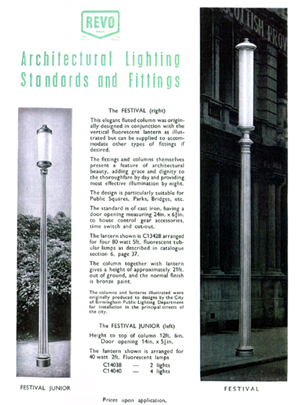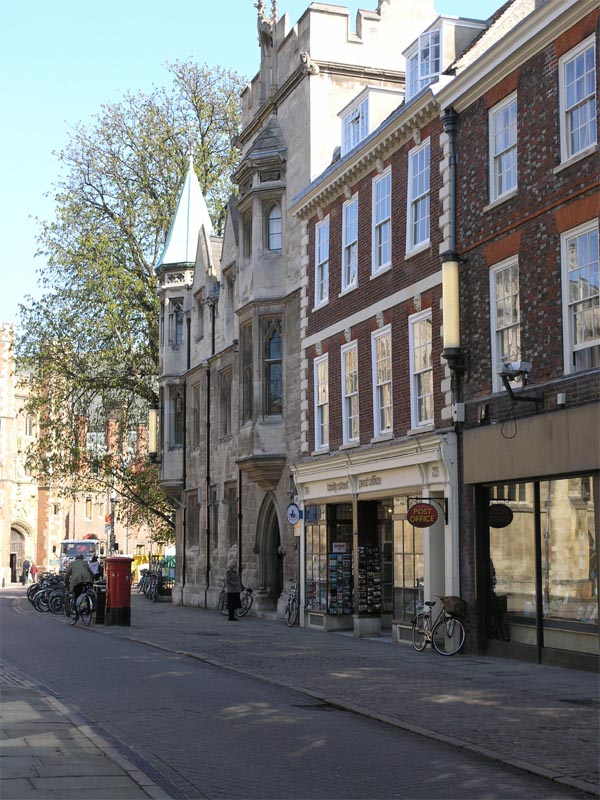 |
REVO C14911 (Richardson Candle)
Genre: Enclosed Vertical Tubular Fluorescent Lantern
After the invention of the tubular fluorescent lamp in 1937 by GE of America, its application to street
lighting was immediately recognised, but all development was delayed by the Second World War. After hostilities
ceased, trial installations using tubular fluorescent lamps were installed in Dublin (using trough
reflectors) and a year later in Rugby and London (using scientifically designed lanterns).
The advantages of fluorescent tubes were immediately apparent. The fluorescent tube was ideally suited for road
lighting, casting a wide beam across the road surface and was relatively unaffected by wet conditions
(which lead to streaks from more compact light sources). It's non-dazzling white light (due to the low
surface brightness of the tube itself) made it an ideal solution for the lighting of high streets, promenades and
civic areas, with smaller units used for residential streets. The only problem was the size of the tubes, which in turn
lead to large lanterns.
The first fluorescent lanterns were huge, bulky affairs, their size dictated by the bulb lengths, the enormous gear
and the limitations of the raw materials of the late 1940s: the lanterns consisted of plate glass panels and metal frames. The optical
system was also complex
treating each lamp as individual source and concentrating its beam in one area using parabolic polished
metal reflectors. Their large size, and equally large capital cost, made lighting authorities hesitant to use
these lanterns.
Fluorescent's popularity increased as new aluminium alloys allowed lighter one-piece canopies to be cast,
which in turn supported new plastic moulded bowls. The optical systems changed again with all the tubes
contributing to the whole: a primary system of lightweight plastic refractors directed the flux onto the road
surface and fashioned the main beams; whilst a secondary system (comprising of white over-reflector)
directed light above the horizontal back to the refractor plates.
Therefore the lanterns became simpler to manufacture and, in turn, their purchase price decreased. They
were still an expensive option, but authorities could justify their use due to their excellent white light (as
compared to the more "artificial" coloured mercury and sodium lanterns). Fluorescent lighting was especially
popular in new town developments and many manufacturers pointed this out in advertisements.
The lantern's large size was still a problem and manufacturers took a tip from European practise and angled
the lantern slightly to disguise its length. Whilst this threw the light further across the road, it was usually
done for cosmetic reasons alone.
The 1950s and 1960s were the age of the fluorescent lantern: it's white light seen as an energy efficient
replacement for ageing tungsten and gas lighting. As gear sizes were gradually decreased, the manufacturers
took advantage by streamlining the lanterns further. Optical systems became simpler until they eventually
consisted of no more than the tubes themselves with a small over reflector.
The energy crisis of the 1970s prompted a rethink. The complex white light fluorescent lantern, usually
burning multiple tubes, was seen as an expensive luxury: a unit burning two 40W bulbs could be replaced by
a single low pressure sodium lantern burning a 35W bulb. The idea that orange light was unsuitable for
residential areas and high streets was swept away by economic necessity. Therefore, as an energy saving measure,
the tubular fluorescent lantern was gradually removed, to the extent that hardly any exist on
public streets anymore.
The use of the tubular fluorescent lamp for street lighting was over. (Although the future looks bright for the
compact fluorescent lamp but that's another story...)

Name: REVO C14911 (Richardson Candle)
Date: 1957
Dimensions: Diameter: 15.5", Height: 78.5"
Light Distibution: (No optical control)
Lamp: 3 (Wall Mounted) or 4 (Column Mounted) x 80W MCFE/U
History
 For the history of the Richardson Candle, see this section.
For the history of the Richardson Candle, see this section.

Part of Trinity Street, Cambridge with two wall-moutned REVO Richardson Candle lanterns.
Popularity
The Richardson Candle was a bespoke design only made for the City Of Cambridge. Only 120 were produced. Of that number,
between a third remain and have now been Grade II listed.
Identification
The Candle is typical of post-war vertial fluorescent lantern design. However, identification is simple: if you're
in Cambridge then it's a Richardson Candle; if you're not in Cambridge, then it's something else.
Optical System
In a word: none. The light is essentially totally uncontrolled, the Perspex tube acting as a giant diffuser,
disguising the multiple light sources within, and scattering light in accordance to the cosine law.
Gear
All the gear was mounted on the central spine of the lantern of wall mounted units (like this example). I believe
the gear was mounted in the base of the column for column mounted units as there would've been little room in the lantern
body once the fourth tube was added.
REVO C14911 (Richardson Candle) In My Collection

|
|
base bracket
The Candle is constructed piecemeal from several separate parts and assemblies. Most of the castings
bear embossed part numbers. In this picture, the wall plate (C14911WP) and the right-angled base joint
(C14911B) have been fixed to the wall. The main part of the Candle assembly, the central
spine and gear compartment, will then slot onto the spigot of the base joint.
|
|

|
|
central assembly
The base compartment (C14910BC) and central pillar (C14911CP) has now been fitted on the base joint.
The spigot is fixed into place by three allen grub screws. The base compartment carries the three lamp holders whilst
the central pillar carries the enclosed gear compartment, lamp supports, wiring and a large threaded assembly at its
top for the top dish and finials.
|
|

|
|
gear compartment
The gear compartment is opened by unscrewing three knurled screws. This opens on three hinges to reveal
the original gear. The instant start switch gear – three so there’s one for each tube – is mounted at the
top of the gear compartment whilst the two power correction capacitors are mounted near the base. The wiring is
coloured (yellow, red and black) for each tube.
|
|

|
|
gear
The manufacturer stickers for the instant start switch gear have long gone but the power correction capacitors
still retain their details. They are made by REVO and are stamped with the date 1956 – this
corresponds to the original 1957 installation date.
|
|

|
|
tube connectors
The central assembly includes fixed porcelain BC lampholders in the base and free brass BC lampholders at the top.
The connection for each tube is facilitated by matching the colour of the wiring. (In this case, the red wired
top bayonet connector would be used on the left, the yellow wired top connector in the centre and the black
wired connector on the right.) These lamp holders are original to the lantern as the original T12 80W fluorescent
tubes would've been fitted with bayonet connectors. Rather than replace them, the lampholders have been fitted with
bayonet to bi-pin converters so the lantern can accept modern T8 and T12 fluorescent tubes.
|
|

|
|
testing
The first wiring tests revealed that one of the instant start gear transformers has failed open circuit.
A replacement was also faulty and quickly burned out any tubes connected to it. Therefore the Candle
is currently operated with only two tubes working – this provides enough light to illuminate the patio and isn't
apparent when the diffuser is fitted.
|
|

|
|
diffuser
The diffuser is fitted by lowering it over the central assembly. This is a difficult job as it is extremely heavy.
The old Perspex is now showing signs of mosaic cracking – a trait shared with the diffuser of the REVO Festival,
and is a problem with old 1950s Perspex. The top dish (C14910D) and finial (C14284F) are now
fitted – the dish carries the bolted attachment for the supporting top plate (C3134SP) which is also fitted to the wall.
|
REVO C14911 (Richardson Candle): As Aquired
These two wall-mounted Richardson Candles were removed from a studio apartment in the former Spratts Dog Biscuit Factory
in East London back in 2012. The owners had recently moved in and found the two Candles – which straddled the
two mezzanine floors of their apartment – rather overbearing and so asked if I would be interested in purchasing them.
The previous owner of the apartment was apparently one of the creators of Spitting Image. Whilst Law and Fluck would've
been London based in the 1980s, both relocated in the 1990s so this provenance that either was the previous
owner is unlikely. It’s more likely that either Law or Fluck were the first owners of the apartment when the
factory was converted in 1985. Both men went to Art College in Cambridge and may have noticed the
Richardson Candles – so
there’s that connection. The new owners also had a receipt for the Candles from a reclaim yard but couldn’t find it.
The Spratts Compex was converted into apartments between 1985 and 1989. This coincides with the removal of around
a third of the Richardson Candles when Bridge Street through to St. Andrews Street, Petty Cury and Market Street
were relit. Many of the columns were removed to Solopark, a local reclaim yard in Cambridgeshire, and I remember them
being stacked on palettes in the yard for many years. However, when I visited in the 1990s, there was never any sign of
the original lanterns. A local councillor told me that the lanterns themselves had probably been retained for spares.
Piecing together what little information I have, I believe these two wall-mounted Richardson Candles were removed from
Cambridge in the late 1980s, were not retained for spares and ended up at Solopark. They were subsequently purchased
and then installed in the newly refurbished Spratts development until 2012.
I have mounted one of the Richardson Candles on the wall of our house. The other
Richardson Candle now resides in Eastbourne
with another collector.

|



